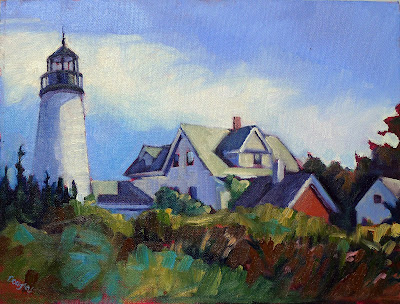Be nimble or perish. Find new ways to do things, or resign yourself to “go gentle into that good night.”
 |
| The Day Begins, mural by Peter Yesis, Waldo County Justice Center |
Whenever I mention to my husband how fine a painter Peter Yesis is, Doug answers that it’s because Peter trained as an electrical engineer. I suspect there’s some truth in that. Engineering teaches orderly processes, and it’s dispassionate. There’s no flailing about, examining one’s soul, in circuit design.
Peter has been as thoughtful about his career as he is about painting. In recent years, he found a way to use Maine’s Percent for Artto get his work into public buildings. The kind of painting Peter (and I) do has been obsolete in public architecture for fifty years. For most of our careers, it would have been easier to sell concrete canoes for the steps of a public building than an ‘old-fashioned’ landscape painting for its lobby. I wouldn’t have tried. And yet Peter persevered, calling his paintings ‘murals’ lest anyone get the wind up.
 |
| Peter and his newest mural at the Oxford County Courthouse. |
I have sat through a murder trial of someone I cared about. It’s a terrifying experience. Rochester’s antiseptic, 1970s-era-courtroom provided no distractions from the litany of evidence. Had the trial been in Waldo County, Maine, I could have occasionally studied Peter’s painting of dawn breaking over the Passagassawaukeag, above. Art’s value may be hard to quantify, but that doesn’t make it non-existent.
Since 1982, Percent for Art has put almost $8 million in artwork into Maine schools, courthouses and other public buildings. I’m not a fan of government art funding, but this is a case of government buying art, just as they buy other furnishings.
Yesterday, Peter went to Paris, ME to install three murals at the Oxford County Courthouse. As Maine’s economy teeters in these parlous times, his project put me in mind of the Federal Art Project, the WPA initiative that did so much to change America’s public buildings during the Great Depression.
 |
| One of three murals painted by Peter Yesis for the Oxford County Courthouse. |
(Great bureaucracies might, like ocean liners, have momentum of their own, but they are still steered by a captain. The Federal Art Project was a success largely because of the sensitive leadership of Holger Cahill. In Maine, that captain is Julie Richard. She too steers a tight course.)
The tiny post office in Middleport, NY, has murals painted by WPA artist Marianne Appel. Neither the town nor the artist are ‘significant,’ but that post office has an abiding place in my memory because of those murals. Peter will be remembered in Maine because he has placed his art in locations that matter.
On a practical level, he has found a niche. I’ve known him long enough to know that he got there not with a grand master plan, but by trial and error. He will continue to tinker, even though he—like me—is at an age when many of our peers are contemplating retirement.
 |
| Kim and Peter Yesis installing a mural at the Oxford County Courthouse. |
For every tale of frustration in the current crisis, there’s another of opportunity. Yesterday I talked with an elementary-school art teacher. She told me about her response to sudden lockdown this past spring. Her kids had no art supplies at home, so she encouraged them to make art with recycled materials. This year, she’s made kits for them to use at home. She’s doing her best to cope with something none of us wanted. Along the way she’s discovering new ways to teach art.
The lesson of our age is: be nimble or perish. Find new ways to do things, or resign yourself to “go gentle into that good night.”










